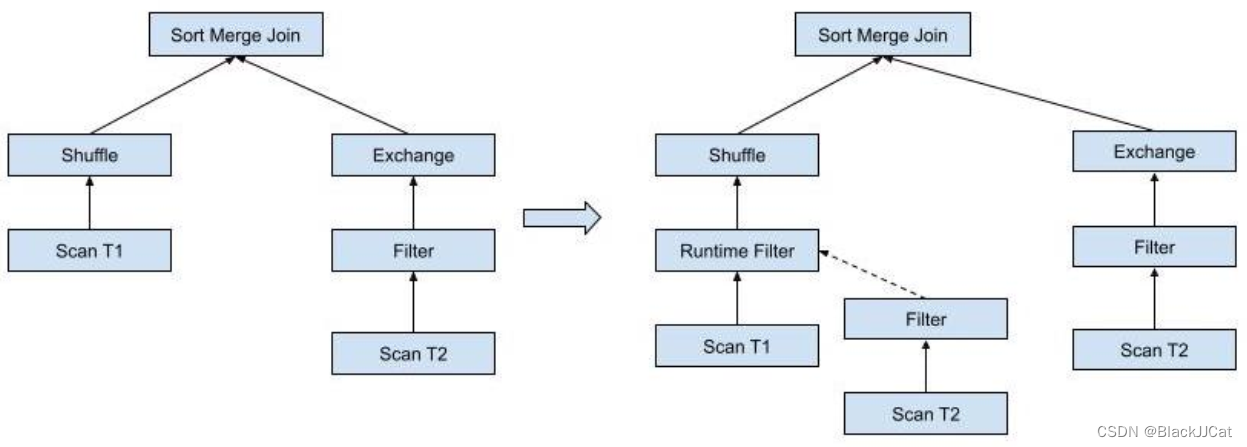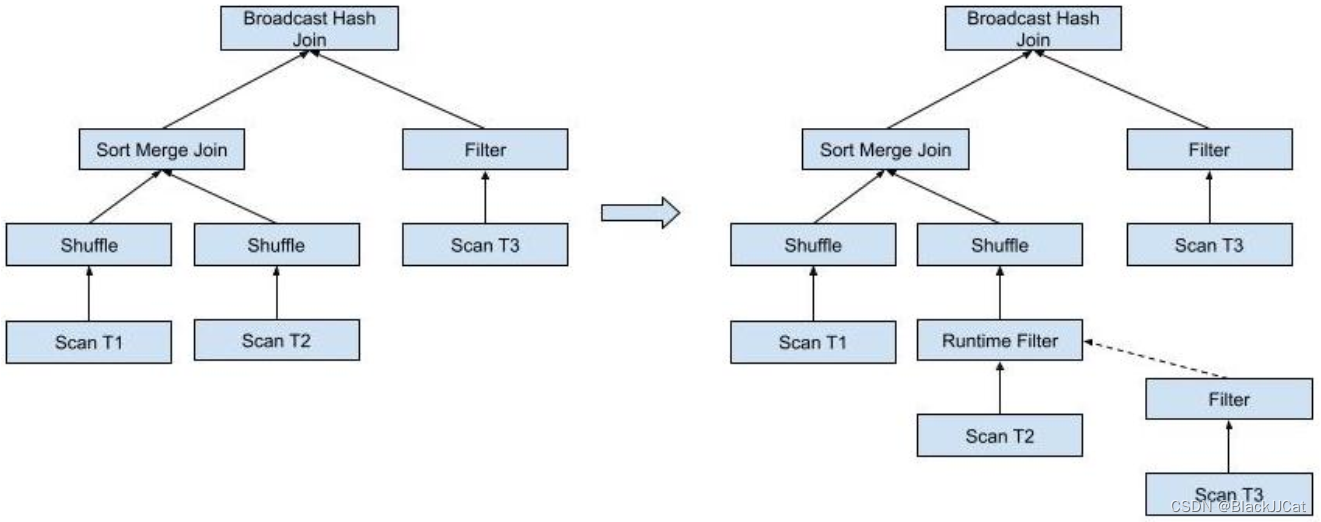1 综述
1.1 目的
Bloom Filter Join,或者说Row-level Runtime Filtering(还额外有一条Semi-Join分支),是Spark 3.3对运行时过滤的一个最新补充
之前运行时过滤主要有两个:动态分区裁剪DPP(开源实现)、动态文件裁剪DFP(Databricks实现),两者都能有效减少数据源层面的Scan IO
Bloom Filter Join的主要优化点是在shuffle层,通过在join shuffle前对表进行过滤从而提高运行效率
1.2 场景
- 普通的shuffle join

- Broadcast join并且子结构中存在shuffle

1.3 基础过程
将存在过滤条件的小表端称为Filter Creation Side,另一层称为Filter Application Side
对于如下的SQL:SELECT * FROM R JOIN S ON R.r_sk = S.s_sk where S.x = 5
首先Creation端进行bloomFilter创建,简单来说就是对小表创建一个bloomFilter的过滤数据集合
SELECT BloomFilterAggregate(XxHash64(S.s_sk), n_items, n_bits)FROM S where S.x =5
之后Application端进行重写(实际是整个查询重写),就是把小表的bloomFilter数据集合拿来对大表的数据进行过滤
根据上面的场景图看,其实小表Creation端在整个SQL树上并没有变化,只改变了大表端的树结构
SELECT*FROM R JOIN S ON R.r_sk = S.s_sk
WHERE S.x=5AND BloomFilterMightContain((SELECT BloomFilterAggregate(XxHash64(S.s_sk), n_items, n_bits) bloom_filter
FROM S where S.x =5),-- Bloom filter creation
XxHash64(R.r_sk))-- Bloom filter application
1.4 触发条件
设计文档中写的触发条件
- 小表在broadcast join当中(存疑)
- 小表有过滤器
- 小表是Scan (-> Project) -> Filter的建档形式,否则依赖流增加可能延长查询时间
- 小表是确定性的
- 大表端有shuffle,小表可以通过shuffl传送bloomFilter结果
- join的列上没有应用DPP
2 InjectRuntimeFilter
InjectRuntimeFilter是Spark源码中对应的优化器类,只执行一次(FixedPoint(1)和Once的差异是Once强制幂等)
Batch("InjectRuntimeFilter",FixedPoint(1),InjectRuntimeFilter):+
apply中定义了规则的整体流程,前面是两个条件判断
// 相关子查询不支持,相关子查询的子查询结果依赖于主查询,不能应用case s:Subqueryif s.correlated => plan
// 相关的配置开关是否开启case _ if!conf.runtimeFilterSemiJoinReductionEnabled &&!conf.runtimeFilterBloomFilterEnabled => plan
case _ =>// 应用优化规则,尝试注入运行时过滤器
val newPlan =tryInjectRuntimeFilter(plan)// semi join配置未开或者规则应用后无变化,不处理if(conf.runtimeFilterSemiJoinReductionEnabled &&!plan.fastEquals(newPlan)){// 子查询重写成semi/anti joinRewritePredicateSubquery(newPlan)}else{
newPlan
}
相关的配置为,默认bloomFilter开启了,Semi join关闭的
val RUNTIME_FILTER_SEMI_JOIN_REDUCTION_ENABLED=buildConf("spark.sql.optimizer.runtimeFilter.semiJoinReduction.enabled").doc("When true and if one side of a shuffle join has a selective predicate, we attempt "+"to insert a semi join in the other side to reduce the amount of shuffle data.").version("3.3.0").booleanConf
.createWithDefault(false)
val RUNTIME_BLOOM_FILTER_ENABLED=buildConf("spark.sql.optimizer.runtime.bloomFilter.enabled").doc("When true and if one side of a shuffle join has a selective predicate, we attempt "+"to insert a bloom filter in the other side to reduce the amount of shuffle data.").version("3.3.0").booleanConf
.createWithDefault(true)
2.1 tryInjectRuntimeFilter
tryInjectRuntimeFilter使用核心的处理流程,尝试应用Runtime Filter,整体代码如下
private def tryInjectRuntimeFilter(plan:LogicalPlan):LogicalPlan={var filterCounter =0
val numFilterThreshold = conf.getConf(SQLConf.RUNTIME_FILTER_NUMBER_THRESHOLD)
plan transformUp {case join @ ExtractEquiJoinKeys(joinType, leftKeys, rightKeys, _, _, left, right, hint)=>var newLeft = left
var newRight = right
(leftKeys, rightKeys).zipped.foreach((l, r)=>{// Check if:// 1. There is already a DPP filter on the key// 2. There is already a runtime filter (Bloom filter or IN subquery) on the key// 3. The keys are simple cheap expressionsif(filterCounter < numFilterThreshold &&!hasDynamicPruningSubquery(left, right, l, r)&&!hasRuntimeFilter(newLeft, newRight, l, r)&&isSimpleExpression(l)&&isSimpleExpression(r)){
val oldLeft = newLeft
val oldRight = newRight
if(canPruneLeft(joinType)&&filteringHasBenefit(left, right, l, hint)){
newLeft =injectFilter(l, newLeft, r, right)}// Did we actually inject on the left? If not, try on the rightif(newLeft.fastEquals(oldLeft)&&canPruneRight(joinType)&&filteringHasBenefit(right, left, r, hint)){
newRight =injectFilter(r, newRight, l, left)}if(!newLeft.fastEquals(oldLeft)||!newRight.fastEquals(oldRight)){
filterCounter = filterCounter +1}}})
join.withNewChildren(Seq(newLeft, newRight))}}
过程中有很多的条件判断,应用Runtime Filter的基本条件:
- 插入的Runtime Filter没超过阈值(默认10)
- 等值条件的Key上不能有DPP、Runtime Filter
- 等值条件的Key是一个简单表达式(即没有套上UDF等)
之后根据条件,选择将Runtime Filter应用到左子树还是右子树,条件为
- Join类型支持下推(比如RightOuter只能用于左子树)
- Application端支持通过joins、aggregates、windows下推过滤条件
- Creation端有过滤条件
- 当前join是shuffle join或者是一个子结构中包含shuffle的broadcast join
- Application端的扫描数据大于阈值(默认10G)
提到的两个阈值的配置项
val RUNTIME_FILTER_NUMBER_THRESHOLD=buildConf("spark.sql.optimizer.runtimeFilter.number.threshold").doc("The total number of injected runtime filters (non-DPP) for a single "+"query. This is to prevent driver OOMs with too many Bloom filters.").version("3.3.0").intConf
.checkValue(threshold => threshold >=0,"The threshold should be >= 0").createWithDefault(10)
val RUNTIME_BLOOM_FILTER_APPLICATION_SIDE_SCAN_SIZE_THRESHOLD=buildConf("spark.sql.optimizer.runtime.bloomFilter.applicationSideScanSizeThreshold").doc("Byte size threshold of the Bloom filter application side plan's aggregated scan "+"size. Aggregated scan byte size of the Bloom filter application side needs to be over "+"this value to inject a bloom filter.").version("3.3.0").bytesConf(ByteUnit.BYTE).createWithDefaultString("10GB")
2.2 injectFilter
injectFilter是核心进行Runtime Filter规则应用的地方,在此处,bloomFilter和Semi Join是互斥的,只能有一个执行
if(conf.runtimeFilterBloomFilterEnabled){injectBloomFilter(
filterApplicationSideExp,
filterApplicationSidePlan,
filterCreationSideExp,
filterCreationSidePlan
)}else{injectInSubqueryFilter(
filterApplicationSideExp,
filterApplicationSidePlan,
filterCreationSideExp,
filterCreationSidePlan
)
2.3 injectBloomFilter
2.3.1 执行条件
首先进行一个判断,在Creation端的数据不能大于阈值(Creation端数据量大会导致bloomFilter的误判率高,最终过滤效果差)
// Skip if the filter creation side is too bigif(filterCreationSidePlan.stats.sizeInBytes > conf.runtimeFilterCreationSideThreshold){return filterApplicationSidePlan
}
阈值配置默认10M
val RUNTIME_BLOOM_FILTER_CREATION_SIDE_THRESHOLD=buildConf("spark.sql.optimizer.runtime.bloomFilter.creationSideThreshold").doc("Size threshold of the bloom filter creation side plan. Estimated size needs to be "+"under this value to try to inject bloom filter.").version("3.3.0").bytesConf(ByteUnit.BYTE).createWithDefaultString("10MB")
Creation端的数据是一个预估数据,是LogicalPlan中的属性LogicalPlanStats获取的,分是否开启CBO,具体获取方式待研究
def stats:Statistics= statsCache.getOrElse {if(conf.cboEnabled){
statsCache =Option(BasicStatsPlanVisitor.visit(self))}else{
statsCache =Option(SizeInBytesOnlyStatsPlanVisitor.visit(self))}
statsCache.get
}
2.3.2 创建Creation端的聚合
就是创建一个bloomFilter的聚合函数BloomFilterAggregate,是AggregateFunction的子类,属于Expression。根据统计信息中是否存在行数,会传入不同的参数
val rowCount = filterCreationSidePlan.stats.rowCount
val bloomFilterAgg =if(rowCount.isDefined && rowCount.get.longValue >0L){newBloomFilterAggregate(newXxHash64(Seq(filterCreationSideExp)), rowCount.get.longValue)}else{newBloomFilterAggregate(newXxHash64(Seq(filterCreationSideExp)))}
2.3.3 创建Application端的过滤条件
根据1.3中的描述,此处就是把上节中Creation端创建的bloomFilter过滤条件构建成Application端的条件
Alias就是一个别名的效果;ColumnPruning就是进行列裁剪,后续不需要的列不读取;ConstantFolding就是进行常量折叠;ScalarSubquery是标量子查询,标量子查询的查询结果是一行一列的值(单一值)
BloomFilterMightContain就是一个内部标量函数,检查数据是否由bloomFilter包含,继承自Predicate,返回boolean值
val alias =Alias(bloomFilterAgg.toAggregateExpression(),"bloomFilter")()
val aggregate =ConstantFolding(ColumnPruning(Aggregate(Nil,Seq(alias), filterCreationSidePlan)))
val bloomFilterSubquery =ScalarSubquery(aggregate,Nil)
val filter =BloomFilterMightContain(bloomFilterSubquery,newXxHash64(Seq(filterApplicationSideExp)))
最终结果是在原Application端的计划树上加一个filter,如下就是最终的返回结果
Filter(filter, filterApplicationSidePlan)
2.4 injectInSubqueryFilter
injectInSubqueryFilter整体流程与injectBloomFilter差不多,差异应该是在Application端生成的过滤条件变成in
val actualFilterKeyExpr =mayWrapWithHash(filterCreationSideExp)
val alias =Alias(actualFilterKeyExpr, actualFilterKeyExpr.toString)()
val aggregate =ColumnPruning(Aggregate(Seq(filterCreationSideExp),Seq(alias), filterCreationSidePlan))if(!canBroadcastBySize(aggregate, conf)){// Skip the InSubquery filter if the size of `aggregate` is beyond broadcast join threshold,// i.e., the semi-join will be a shuffled join, which is not worthwhile.return filterApplicationSidePlan
}
val filter =InSubquery(Seq(mayWrapWithHash(filterApplicationSideExp)),ListQuery(aggregate, childOutputs = aggregate.output))Filter(filter, filterApplicationSidePlan)
这里有一个小优化就是mayWrapWithHash,当数据类型的大小超过int时,就是把数据转为hash
// Wraps `expr` with a hash function if its byte size is larger than an integer.private def mayWrapWithHash(expr:Expression):Expression={if(expr.dataType.defaultSize >IntegerType.defaultSize){newMurmur3Hash(Seq(expr))}else{
expr
}}
3 BloomFilterAggregate
类有三个核心参数:
- child:子表达式,就是InjectRuntimeFilter里传的XxHash64,目前看起来数据先经过XxHash64处理成long再放入BloomFilter
- estimatedNumItemsExpression:估计的数据量,如果InjectRuntimeFilter没拿到统计信息,就用配置的默认值
- numBitsExpression:要使用的bit数
caseclassBloomFilterAggregate(
child:Expression,
estimatedNumItemsExpression:Expression,
numBitsExpression:Expression,
estimatedNumItemsExpression和numBitsExpression对应的配置如下
val RUNTIME_BLOOM_FILTER_EXPECTED_NUM_ITEMS=buildConf("spark.sql.optimizer.runtime.bloomFilter.expectedNumItems").doc("The default number of expected items for the runtime bloomfilter").version("3.3.0").longConf
.createWithDefault(1000000L)
val RUNTIME_BLOOM_FILTER_NUM_BITS=buildConf("spark.sql.optimizer.runtime.bloomFilter.numBits").doc("The default number of bits to use for the runtime bloom filter").version("3.3.0").longConf
.createWithDefault(8388608L)
BloomFilter用的是Spark自己实现的一个类BloomFilterImpl,BloomFilterAggregate的createAggregationBuffer接口中创建
override def createAggregationBuffer():BloomFilter={BloomFilter.create(estimatedNumItems, numBits)}
参数就是前面的estimatedNumItemsExpression和numBitsExpression,是懒加载的参数(应该在处理过程会被改变,所以实际跟前面的值之间还加了一层与默认值的比较赋值)
// Mark as lazy so that `estimatedNumItems` is not evaluated during tree transformation.private lazy val estimatedNumItems:Long=Math.min(estimatedNumItemsExpression.eval().asInstanceOf[Number].longValue,SQLConf.get.getConf(RUNTIME_BLOOM_FILTER_MAX_NUM_ITEMS))
处理数据的接口应该是update,把数据用XxHash64处理后加入BloomFilter
override def update(buffer:BloomFilter, inputRow:InternalRow):BloomFilter={
val value = child.eval(inputRow)// Ignore null values.if(value ==null){return buffer
}
buffer.putLong(value.asInstanceOf[Long])
buffer
}
对象BloomFilterAggregate有对应的序列化和反序列化接口
object BloomFilterAggregate{final def serialize(obj:BloomFilter):Array[Byte]={// BloomFilterImpl.writeTo() writes 2 integers (version number and num hash functions), hence// the +8
val size =(obj.bitSize()/8)+8require(size <=Integer.MAX_VALUE, s"actual number of bits is too large $size")
val out =newByteArrayOutputStream(size.intValue())
obj.writeTo(out)
out.close()
out.toByteArray
}final def deserialize(bytes:Array[Byte]):BloomFilter={
val in =newByteArrayInputStream(bytes)
val bloomFilter =BloomFilter.readFrom(in)
in.close()
bloomFilter
}}
4 BloomFilterMightContain
有两个参数
- bloomFilterExpression:是上节BloomFilter的二进制数据
- valueExpression:应该跟上节的child一致,对输入数据做处理的表达式,XxHash64
caseclassBloomFilterMightContain(
bloomFilterExpression:Expression,
valueExpression:Expression)
bloomFilter通过反序列化获取
// The bloom filter created from `bloomFilterExpression`.@transientprivate lazy val bloomFilter ={
val bytes = bloomFilterExpression.eval().asInstanceOf[Array[Byte]]if(bytes ==null)nullelsedeserialize(bytes)}
做数据判断的应该是eval,就是调用的BloomFilter的接口进行判断。eval应该就是Spark中Expression表达式的执行接口
override def eval(input:InternalRow):Any={if(bloomFilter ==null){null}else{
val value = valueExpression.eval(input)if(value ==null)nullelse bloomFilter.mightContainLong(value.asInstanceOf[Long])}}
也有doGenCode接口用来生成代码
override def doGenCode(ctx:CodegenContext, ev:ExprCode):ExprCode={if(bloomFilter ==null){
ev.copy(isNull =TrueLiteral, value =JavaCode.defaultLiteral(dataType))}else{
val bf = ctx.addReferenceObj("bloomFilter", bloomFilter, classOf[BloomFilter].getName)
val valueEval = valueExpression.genCode(ctx)
ev.copy(code = code"""
${valueEval.code}
boolean ${ev.isNull} = ${valueEval.isNull};
${CodeGenerator.javaType(dataType)} ${ev.value} = ${CodeGenerator.defaultValue(dataType)};
if (!${ev.isNull}) {
${ev.value} = $bf.mightContainLong((Long)${valueEval.value});
}""")}}
5 计划变更
取Spark单元测试的样例(InjectRuntimeFilterSuite):select * from bf1 join bf2 on bf1.c1 = bf2.c2 where bf2.a2 = 62
- 规则前的plan
GlobalLimit21+-LocalLimit21+-Project[cast(a1#38430 as string)AS a1#38468,cast(b1#38431 as string)AS b1#38469,cast(c1#38432 as string)AS c1#38470,cast(d1#38433 as string)AS d1#38471,cast(e1#38434 as string)AS e1#38472,cast(f1#38435 as string)AS f1#38473,cast(a2#38436 as string)AS a2#38474,cast(b2#38437 as string)AS b2#38475,cast(c2#38438 as string)AS c2#38476,cast(d2#38439 as string)AS d2#38477,cast(e2#38440 as string)AS e2#38478,cast(f2#38441 as string)AS f2#38479]+-JoinInner,(c1#38432= c2#38438):-Filterisnotnull(c1#38432):+-Relation spark_catalog.default.bf1[a1#38430,b1#38431,c1#38432,d1#38433,e1#38434,f1#38435] parquet
+-Filter((isnotnull(a2#38436)AND(a2#38436=62))ANDisnotnull(c2#38438))+-Relation spark_catalog.default.bf2[a2#38436,b2#38437,c2#38438,d2#38439,e2#38440,f2#38441] parquet
- 规则后的plan
GlobalLimit21+-LocalLimit21+-Project[cast(a1#38430 as string)AS a1#38468,cast(b1#38431 as string)AS b1#38469,cast(c1#38432 as string)AS c1#38470,cast(d1#38433 as string)AS d1#38471,cast(e1#38434 as string)AS e1#38472,cast(f1#38435 as string)AS f1#38473,cast(a2#38436 as string)AS a2#38474,cast(b2#38437 as string)AS b2#38475,cast(c2#38438 as string)AS c2#38476,cast(d2#38439 as string)AS d2#38477,cast(e2#38440 as string)AS e2#38478,cast(f2#38441 as string)AS f2#38479]+-JoinInner,(c1#38432= c2#38438):-Filtermight_contain(scalar-subquery#38494[],xxhash64(c1#38432,42))::+-Aggregate[bloom_filter_agg(xxhash64(c2#38438,42),1000000,8388608,0,0)AS bloomFilter#38493]::+-Project[c2#38438]::+-Filter((isnotnull(a2#38436)AND(a2#38436=62))ANDisnotnull(c2#38438))::+-Relation spark_catalog.default.bf2[a2#38436,b2#38437,c2#38438,d2#38439,e2#38440,f2#38441] parquet
:+-Filterisnotnull(c1#38432):+-Relation spark_catalog.default.bf1[a1#38430,b1#38431,c1#38432,d1#38433,e1#38434,f1#38435] parquet
+-Filter((isnotnull(a2#38436)AND(a2#38436=62))ANDisnotnull(c2#38438))+-Relation spark_catalog.default.bf2[a2#38436,b2#38437,c2#38438,d2#38439,e2#38440,f2#38441] parquet
版权归原作者 不甚了然 所有, 如有侵权,请联系我们删除。